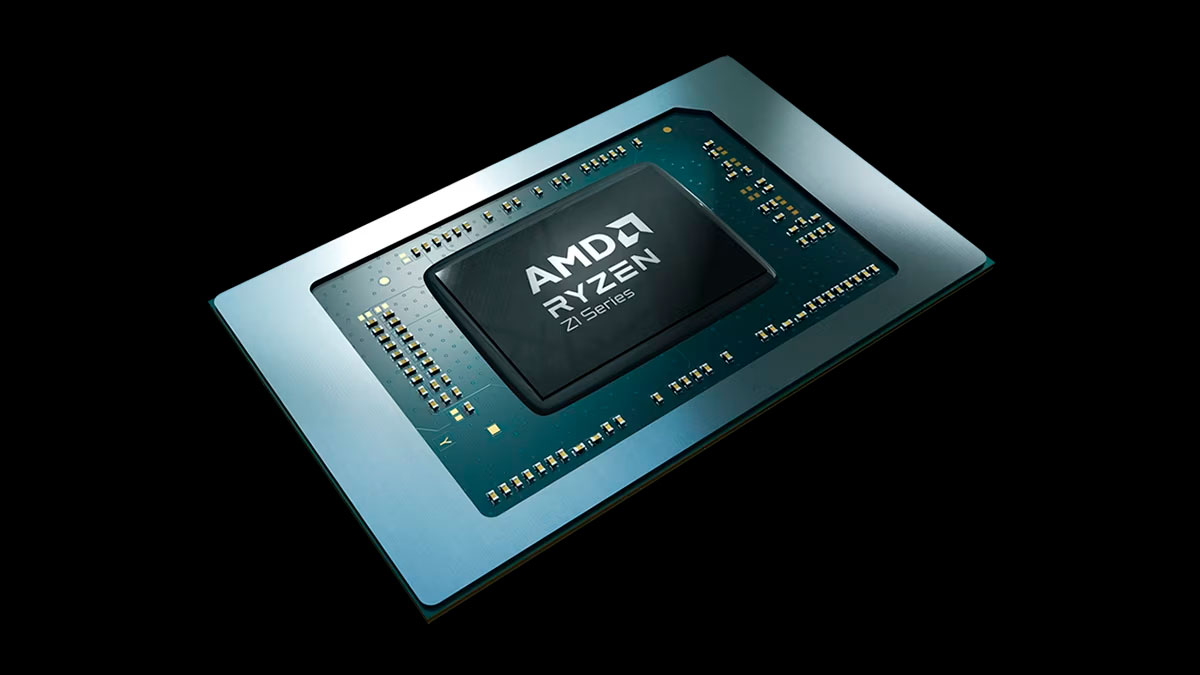
Zen 4 powers some of the best CPUs around. Therefore, it's unsurprising that AMD developed Zen 4c, an offshoot of Zen 4, for the chipmaker's upcoming mobile Phoenix 2 processors. Hardware enthusiast David Huang has provided an exciting insight into the difference between the Zen 4 and Zen 4c cores in Phoenix 2.
Phoenix 2 was slated to launch this year, but we still haven't seen the mobile Ryzen processors in retail laptops yet. However, it seems that Phoenix 2 is already among us, but in the form of AMD's Ryzen Z1 series that is at the heart of handheld PC gaming devices, such as the ROG Ally. HWiNFO, a system information, monitoring, and diagnostics utility, confirms that the Ryzen Z1, codenamed Phoenix2, is on the PHX2-A0 stepping. It differs from AMD's Ryzen 7040U series (Phoenix) with the PHX-A1 stepping. The Ryzen Z1 has been rumored to be a clone of the Ryzen 5 7540U for a long time now.
Phoenix 2 is AMD's first foray into hybrid chips. However, the chipmaker's approach is a bit different from Intel's. For example, Intel utilizes two completely different architectures for the P-cores and E-cores in its hybrid chips, such as Alder Lake (Golden Cove, Gracemont) and Raptor Lake (Raptor Cove, Gracemont). In contrast, AMD leverages the same Zen 4 architecture in Phoenix 2. The advantage is that AMD's E-cores feature simultaneous multithreading, whereas Intel's E-cores lack Hyper-Threading. In AMD's case, Zen 4c is nearly identical to Zen 4, except that the former is 35.4% smaller, making it twice as dense, with lower clock speeds and cache.
| Processor | Zen 4 / Zen 4c Cores | Zen 4 / Zen 4c Boost Clock (GHz) | L3 Cache (MB) | GPU Cores | GPU Clock (GHz) | cTDP (W) |
|---|---|---|---|---|---|---|
| Ryzen 7 7840U | 8 / N/A | 5.1 / N/A | 16 | 12 | 2.7 | 15 - 30 |
| Ryzen Z1 | 2 / 4 | 4.9 / 3.5 | 16 | 4 | 2.8 | 9 - 30 |
The Ryzen Z1 has a hexa-core, 12-thread design. The 7nm chip has two Zen 4 cores and four Zen 4c cores that sport a maximum boost clock up to 4.9 GHz and 3.5 GHz. Huang used a handheld PC with the Ryzen Z1 for testing but didn't specify the model. The Ryzen Z1 had 16GB of LPDDR5X-7500 memory and operates with 15W and 30W modes.
Huang compared the Ryzen Z1 handheld PC against the HP Elitebook 835 G10 with a Ryzen 7 7840U. The Ryzen 7 7840U is an octa-core chip with boost clock speeds up to 5.1 GHz. The laptop has 32GB of LPDDR5-6400 memory, so the Ryzen 7 7840U had access to more memory, albeit at slower speeds. Huang highlighted that the HP Elitebook 835 G10 has a default SPL (sustained power limit) of 25W, which isn't modifiable by the user. That's something to consider when comparing the charts of the two devices with different power limits.
Regarding performance, Zen 4 was up to 30% faster than Zen 4c in the single-threaded integer rate-1 test part of the SPECint benchmark suite. When locked at the same 3.2 GHz clock speed, the performance was identical between the Zen 4 and Zen 4c cores. The test confirms that they are architecturally the same, not like we didn't know before since AMD has revealed as much, but it's always interesting to see it in benchmarks.
| Processor | Cinebench R23 |
|---|---|
| Ryzen 7 7840U | 12,003 |
| Ryzen Z1 (30W) | 10,155 |
| Ryzen Z1 (15W) | 7,822 |
Looking at the overall performance in Cinebench R23, there was a 29.8% difference between the Ryzen Z1 15W and 30W modes. Regardless, the Ryzen 7 7840U was still the faster chip. The Ryzen 7 7840U outperformed the Ryzen Z1 at 15W and 30W by 53.5% and 18.2%, respectively.
Get Tom's Hardware's best news and in-depth reviews, straight to your inbox.
Zen 4c needs a higher core voltage to reach the same clock speeds as Zen 4. The VID (voltage identification definition) charts revealed that Zen 4 hits the Vmin (the minimal voltage that a processor requires for a workload at a particular frequency) at 2.3 GHz. In contrast, Zen 4c arrives at the Vmin below 1.5 GHz. The V/F (voltage-to-frequency) curve for both cores overlaps at 1.5 GHz. Zen 4c's power efficiency resides in between 1.5 GHz and 2 GHz. Zen 4c consumes less power despite the higher recorded voltage due to the more compact design.
As for iGPU performance, the Ryzen 7 7840U delivered up to 65% higher gaming performance than the Ryzen Z1. For context, the Ryzen 7 7840U's iGPU has 12 RDNA 3 compute units with a max 2.7 GHz clock, while the Ryzen Z1 only has four RDNA 3 compute units at 2.8 GHz.

Zhiye Liu is a news editor and memory reviewer at Tom’s Hardware. Although he loves everything that’s hardware, he has a soft spot for CPUs, GPUs, and RAM.
-
GustavoVanni Wait, wait, wait!Reply
You're saying that ROG Ally uses AMD's first hybrid chip with Zen4 and Zen4c and nobody mencioned this in any review in the last few months?
Or is this a different AMD Ryzen Z1? -
bit_user Wow, the 7840U performed only 18.2% better @ 30 W, in spite of having 33.3% more cores (not to mention all big cores)!! It sure would be nice if they had the same memory speeds, so we could know if that's helping the Z1.Reply
Ryzen 7 7840U's iGPU has 12 RDNA 3 compute units with a max 2.7 GHz clock, while the Ryzen Z1 only has four RDNA 3 compute units at 2.8 GHz.
IMO, this makes it pretty nuts that it's being used in gaming handhelds. They really should've gone with 10 or 12 CU. -
greenreaper Fun fact: the RDNA 2 cores in the 7000-series iGPU can run at 2.7-2.8Ghz too, at about 1.3 V (+9 GPU offset). ASUS's convenient tweaker setting for this doesn't seem to work, though; I had to set the one in AMD Overclocking instead (unlike the regular cores).Reply -
NeoMorpheus If i recall correctly, zen4c also support avx-512 unlike intels e cores.Reply
Heck, i think that even some p-cores don’t support it either. -
bit_user Reply
On the P-core -only Xeon processors, they all support AVX-512.NeoMorpheus said:Heck, i think that even some p-cores don’t support it either. -
The Hardcard Reply
The prrevious reviews were with the Z1 Extreme.GustavoVanni said:Wait, wait, wait!
You're saying that ROG Ally uses AMD's first hybrid chip with Zen4 and Zen4c and nobody mencioned this in any review in the last few months?
Or is this a different AMD Ryzen Z1? -
Gillerer Reply
As implied in the article, mobile chips are mostly limited by power so the performance delta at the same power isn't that surprising. If both were allowed more power, the 7840U would run away with it.bit_user said:Wow, the 7840U performed only 18.2% better @ 30 W, in spite of having 33.3% more cores (not to mention all big cores)!! It sure would be nice if they had the same memory speeds, so we could know if that's helping the Z1.
IMO, this makes it pretty nuts that it's being used in gaming handhelds. They really should've gone with 10 or 12 CU.
AMD already has more CUs on the bigger brother Phoenix (1) - which is the 7840U. While enthusiasts would always want a cheap gaming machine, this smaller and cheaper variant is primarily intended for cheaper thin laptops; general use, video playback etc. Tripling the CUs would not benefit anyone but gamers, but would make it less inexpensive, which sort of defeats the purpose of having two different Phoenix dies to begin with. -
SirNathan Reply
The regular Z1 has 4 CUs, but the Z1 Extreme in the ROG Ally and similar handhelds has 12 CUs. Maybe you already knew that, but it definitely confused me the first couple times I read it, and there are probably others who are confused too...bit_user said:Wow, the 7840U performed only 18.2% better @ 30 W, in spite of having 33.3% more cores (not to mention all big cores)!! It sure would be nice if they had the same memory speeds, so we could know if that's helping the Z1.
IMO, this makes it pretty nuts that it's being used in gaming handhelds. They really should've gone with 10 or 12 CU. -
TerryLaze Reply
Huang highlighted that the HP Elitebook 835 G10 has a default SPL (sustained power limit) of 25W, which isn't modifiable by the user.bit_user said:Wow, the 7840U performed only 18.2% better @ 30 W, in spite of having 33.3% more cores (not to mention all big cores)!! It sure would be nice if they had the same memory speeds, so we could know if that's helping the Z1.
IMO, this makes it pretty nuts that it's being used in gaming handhelds. They really should've gone with 10 or 12 CU.
Difference between 25w and 30w is 18.2% ,so much wow, many improve...
The real improvement is this, the c cores can run at lower volts/clocks which means they can run at lower power, they are still way above the 800Mhz that intel can achieve but at least they are doing something.
Zen 4c needs a higher core voltage to reach the same clock speeds as Zen 4. The VID (voltage identification definition) charts revealed that Zen 4 hits the Vmin (the minimal voltage that a processor requires for a workload at a particular frequency) at 2.3 GHz. In contrast, Zen 4c arrives at the Vmin below 1.5 GHz. The V/F (voltage-to-frequency) curve for both cores overlaps at 1.5 GHz. Zen 4c's power efficiency resides in between 1.5 GHz and 2 GHz.